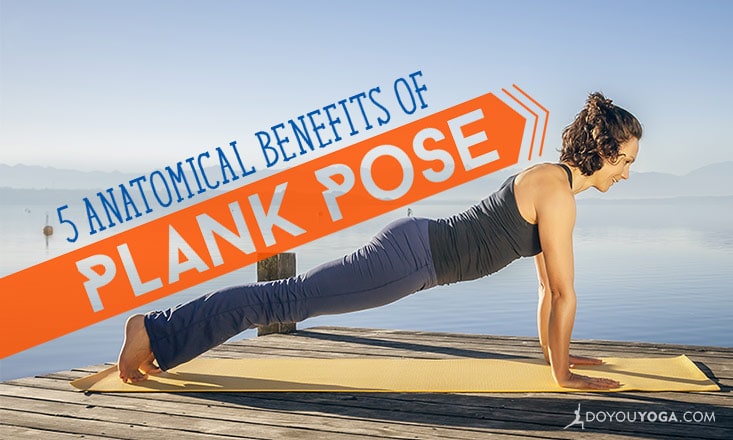Most of us know Plank Pose, Phalakasana, Santolasana, or Utthita Chaturanga Dandasana as a workout for our core, in particular the ab muscles of the torso. However, it has so many more benefits. Here are five more body parts that are benefitting during Plank Pose in addition to those abdominals.
1. Strengthens the Wrists and Hands
Many of the intrinsic muscles of the wrist and hand gain strength and stamina for other activities like racket sports or opening a tight jar.
The wrist bends back toward the top of the forearm (dorsiflexion of the wrist) during Plank Pose, and with that extreme flexion and the applied pressure into the ground, the muscles and tendons gain flexibility and strength.
2. Builds Stronger Triceps
As your push your arms into the ground, the triceps contract consistently (isometrically) as the arms stabilize to hold the body’s weight. Rotate those triceps inward toward each other as you push your arms away from your shoulder sockets and into the floor.
Strong triceps create a stronger biceps-triceps partnership for many arm movements and counteract flabby arms.
3. Strengthens and Lengthens the Neck Muscles
There are no less than 18 muscles in the neck all responsible for different actions of the part of the spine that makes up your neck (the cervical spine).
Some of the muscles of the back of the neck such as the deeply positioned spinalis group and the top of the trapezius are strengthened as you pull your neck up and back to create a long spine. Neck strength is great for holding sound posture, helping to counteract “texting neck.”
You may also sleep more peacefully by finding that your neck is more comfortable resting into your pillow of choice.
4. Works the Spinal Muscles
The spinal extensors, muscles that run nearly the length of the spine in a vertical fashion, are some of the muscles responsible for keeping your back upright and aligned.
Engaging your core (which includes your back muscles, too) during Plank Pose contracts those extensors and strengthens them. Strong spinal extensors can really help to alleviate low back pain.
5. Tones the Buttocks
The gluteus muscles should be turned on during Plank Pose to help maintain neutral hip extension and pelvis position to counteract a heavy pelvis bone sagging due to gravity. A sagging pelvis in Plank can also pull your low back out of alignment.
Working those glutes in Plank Pose gives you one more exercise in your repertoire that can lift that booty.
Modify Plank Pose if you need to, drop the knees, but maintain a long line of the body. Another modification you might try if your wrists are pained: use the forearms instead of the palms as your front grounding point.
What is your favorite reason to practice Plank Pose?


